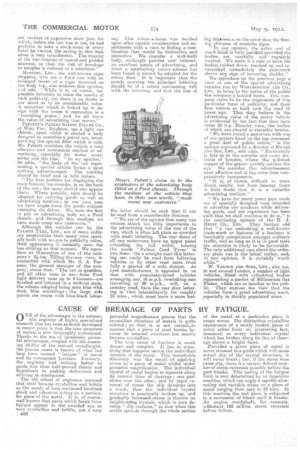CAUSE OF BREAKAGE OF PARTS BY FATIGUE.
Page 32

If you've noticed an error in this article please click here to report it so we can fix it.
0 NE of the advantages to the automobile engineer of highly specialized research that has been so much developed in recent years is that the true structure of metals is now thoroughly understood. Thanks to the use of immensely powerful microscopes, coupled with the reasoning ability of the trained metallurgist., the precise cause is known of what has long been termed " fatigue " of metal and its consequent fracture. Formerly, the engineer had nothing better to guide him than half-proved theory and hypothesis in making deductions and arriving at conclusions.
The old, school of engineers assumed that steel became crystalline and brittle as the result of long-continued localized shock and vibration acting on a particular piece of the metal. It is, of course, well known that parts which break from fatigue appear to the unaided eye as very crystalline and brittle, yet a very 830 powerful magnification proves that the crystalline structure of metals is quite normal; so that it is not, eorreeteto assume that a piece of steel breaks because its internal structure has merely become crystalline.
The true eause of fracture is much deeper and complex. It lies in something that happens within the individual crystals of the metal. This remarkable discovery was the result of applying stress to a piece of metal whilst under powerful magnification. The individual crystal of metal begins to separate along its natural lines of cleavage; came part slides ever the other, and by rapid reversal of stress the slip develops into a crack, thus the individual crystal atrecture is practically broken up, and gradually increased ;stress is thrown on neighbouring crystals, which in turn develop " slip surfaces," so that when this action spreads through the whole section of the. metal at a. particular place it snaps across. The distinctive crystalline appearance of a newly broken piece of metal arises from an interesting fact, inasmuch as every individual crystal which has broken along its line of cleavage shows a bright facet.
Provided a given piece of metal is never stressed to a point which will cause actual slip of the crystal structure, it will never break ; but, if the stress does cause slip, there is a certain defined number of stress reversals possible before the part breaks. This testirre of the fatigue limit is now determined oy an ingenious machine; which can apply a rapidly alternating and variable stress on a piece of metal ranging from zero to 20 tons, In this machine the test piece is subjected to a succession of blows until it breaks. An engine crankshaft, for example, withstood 120 million stress reversals before failure.




































